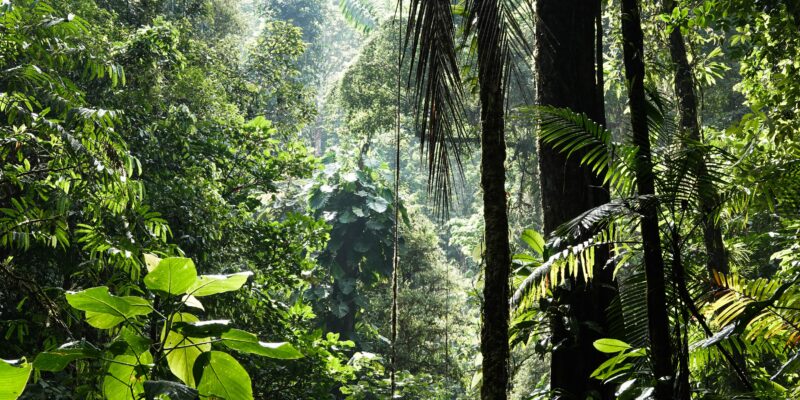Article 6 of the Paris Agreement at COP28: What is at stake?
Developing stringent rules for the global carbon market under A6.4 could set a precedent for high standards and restore faith…

The negative biodiversity impacts of some developments cannot be avoided, minimised or restored. Biodiversity offsetting is a form of impact mitigation that aims to compensate for these negative biodiversity impacts – at least in theory – by protecting, enhancing or restoring similar habitat elsewhere. These biodiversity offsets are based on a ‘no net loss’ policy – in other words, overall biodiversity is left no worse off than if the development had not happened.
For example, a developer clears land to build a mine and then compensates for the resulting loss of biodiversity by either purchasing degraded land and restoring the ecosystem on it, or by purchasing land that has a natural ecosystem on it and protecting it – under the assumption that it is likely to become degraded in the future.
Biodiversity offsetting is now widely used to compensate for biodiversity losses from developments and is part of planning and decision-making processes. For example, as a component of mandated Environmental Impact Assessments for developments.
But, as a conservation practice, biodiversity offsetting is highly controversial. Critics are concerned that offsets may be used by companies to meet their environmental targets without making any meaningful changes to their unsustainable practices. Parallels can be drawn with carbon offsets: For example, a fossil fuel company offsets its carbon emissions by planting a forest to remove CO2 from the atmosphere, rather than actually reducing its emissions, thereby “trading a known amount of emissions with an uncertain amount of emissions reductions”, the consequence of which could be a net increase in emissions.
Similarly, the consequences of biodiversity offsetting are, ultimately, increased biodiversity loss. This is in part because most offset projects compensate for a lost ecosystem by protecting land that might be lost in the future. Offset policies mostly define ‘no net loss’ against a baseline of what would have happened without the project and its offset. If the biodiversity loss from future degradation is overestimated, then the positive contribution of the offset will also be overestimated, giving the developer more scope to have a negative impact on biodiversity. While this may be defined as ‘no net loss’ within the current framework, the outcome would be less biodiversity than if the project had not happened.
In response to these criticisms, biodiversity credits, or biocredits, which are typically purchased voluntarily, have emerged to direct money “towards meaningful and well-designed biodiversity conservation and management”. Biodiversity credits are investments in projects that support biodiversity conservation, but which do not imply biodiversity loss elsewhere. A 2022 report from the International Institute for Environment and Development (IIED) and the United Nations Development Programme (UNDP) endorses biocredits, arguing that because biocredits, unlike biodiversity offsetting, do not imply biodiversity loss elsewhere, they represent a “positive investment in biodiversity” that companies or other entities – such as philanthropists – can choose to make.
However, whether biocredits would realistically be used for non-offsetting purposes is a point of contention. There is also concern that policies may weaken over time under increasing pressure from developers, and that frameworks are being redefined to include financial and other non-environmental metrics, which could facilitate claims of success when the environmental contribution is, in fact, weak. Some also argue that without enforcement, there will not be sufficient investment in biocredit projects.
But the IIED and UNDP report is clear that, if used correctly, biocredits can contribute meaningfully to nature conservation and restoration. To ensure this, “buyers should be screened to ensure they are not using the credit to offset damage elsewhere” and “the investment in the purchase of the biocredits [should] maximise the social and biological impact compared to other potential investments”. The report also recommends that the metrics used to define a unit of biodiversity should include its cultural and social value.
The concept of ‘no net loss’ does not sit well with ecologists because it fails to recognise that biodiversity exists within complex ecosystems and cannot easily be isolated from its social, historical and evolutionary context. Because of this complexity, the losses arising from development cannot be properly quantified, and so it is impossible to know what needs to be compensated for. In fact, a 2021 study found “no evidence that biodiversity gains from offsets actually compensate for development-associated losses, because losses were never estimated”.
Moreover, as the ecological circumstances of two areas will never be identical, offsetting the impacts to one area by restoring or conserving another will always result in some degree of biodiversity loss.
Though a development may only be impacting a small area of land, the land required for compensating for this development may be much bigger – indeed, policy often requires that at least twice the area of biodiversity loss must be protected. Conservationists worry that there is simply not enough land available to compensate for expected biodiversity losses from future development.
There is also concern that increased focus on the trading of biodiversity credits will draw attention away from other, more robust, conservation actions. It could create even more scope for greenwashing – tricking consumers into thinking that their choice is sustainable through a false claim – if badly designed offsets or biocredits are marketed as supporting biodiversity or social equality.
As biocredit schemes are aimed at providing both economic and environmental benefits, this may also allow financial markets and short-term speculators to determine the price of conservation, thereby framing the value of conservation purely in terms of its profitability. But, assigning monetary value to nature does not always promote the conservation of biodiversity and may, in fact, result in the opposite. This also creates a “dangerous and misleading illusion of the substitutability” of critical ecosystem services that may actually be irreplaceable.
In December 2022, the United Nations Biodiversity Conference (COP 15) concluded with the establishment of the Kunming-Montreal Global Biodiversity Framework (GBF). The core aim of this framework is to tackle the alarming decline in biodiversity, facilitate the restoration of ecosystems, and safeguard the rights of indigenous communities. It garnered widespread recognition for its progress in connecting human rights with biodiversity, encompassing concrete measures to stop and reverse the decline of natural ecosystems.
A pivotal target of the GBF is the commitment to safeguard 30% of the earth’s surface and 30% of degraded ecosystems by 2030. It also includes provisions for increased financial assistance to support developing nations in their conservation efforts.
However, a component of the GBF called Target 19 remained unchanged, despite reservations expressed prior to COP 15 by a group of 119 experts. The target underscores the importance of “increas[ing] the levels of financial resources made available from all sources… towards nature-positive economies” and “stimulating innovative schemes… such as biodiversity offsets [and] carbon credits”. Concerns revolved around the potential for the monetisation of nature, the creation of a global market for trading biodiversity credits, and the promotion of biodiversity offsetting without the requisite rigor to ensure a comprehensive reduction and reversal of biodiversity loss within the prescribed time frame.
The GBF has rapidly propelled global initiatives forward. The UK, France, Australia and the EU are at the forefront of promoting “nature markets”.
In March 2023, the UK government unveiled plans to launch three separate nature markets, one for biodiversity offsets, another for flood mitigation and one for clean water. These are to be integral to the UK’s Environmental Improvement Plan 2023, with the goal of increasing private financing for nature to a minimum of GBP 500 million annually by 2027 and GBP 1 billion cumulatively by 2030.
The UK and France are taking the lead in advocating for a global biodiversity credit market. They jointly introduced the Global Biodiversity Credits Roadmap in June 2023, which aligns with the GBF and outlines a strategy to expand worldwide efforts to support companies in procuring biodiversity credits. Working towards COP 16 in 2024, the two countries have committed to bringing together global expertise on biodiversity credits and establishing working groups to explore best practices, ranging from credit funding governance to monitoring frameworks. The Roadmap also intends to address the equitable distribution of income from biodiversity credits.
Australia has a well-established presence in biodiversity offsetting markets, with both existing and new initiatives in development. All six Australian states have implemented compliance-based biodiversity offsetting schemes, alongside a federal biodiversity offset scheme. Recently, the Northern Territory introduced a new policy framework for biodiversity offsets. The determination of offsets typically takes place on a case-by-case basis, with assessments considering the impact on critical species or habitats.
In addition to the existing offsetting schemes, Australia’s government is working on establishing a Nature Repair market, a controversial initiative aimed at addressing the funding gap for nature conservation and restoration in Australia. This initiative seeks to stimulate private investment in biodiversity efforts by rewarding landholders who actively engage in nature preservation. The Australia’s Minister of the Environment, Tanya Plibersek, stated that the initiative aims to turn Australia into the “Green Wall Street”.
The proposal faced significant backlash from members of the opposition bench, due to concerns about integrity and its potential for actual impact. Additionally, think tank The Australia Institute criticised the government’s insufficient environmental and economic justification for the scheme, stating that it cited unsubstantiated financial projections from a PwC report. As a result, the Committees have extended their deliberation period without a specified end date.
In its most recent update to the EU Taxonomy for sustainable activities, the EU has chosen to include an element of biodiversity offsetting. This decision ignores the recommendation provided by the Platform on Sustainable Finance, a group of advisors to the EU’s executive branch, which had called for the removal of it from the list of economic activities related to biodiversity protection and nature restoration due to potential interpretational issues. Nonetheless, the EU decided to include it, albeit with slightly altered phrasing, leading to confusion over its precise meaning.
The decision has faced significant criticism from NGOs and civil society groups. In an open letter, they called for the removal of biodiversity offsetting, claiming that “offsetting is only compensating significant harm elsewhere and thus cannot represent a substantial contribution” to meeting the EU’s biodiversity objectives.
The most straightforward solution is to avoid biodiversity losses as much as possible, with offsetting only used as a last resort.
Biocredits can encourage positive investment in biodiversity if strict accountability guidelines are followed and governance is transparent, and if a holistic approach that considers social, cultural and biological value is used.
Another potential solution is target-based ecological compensation, a new policy framework that offers an alternative to traditional biodiversity offsetting. It requires that compensation for biodiversity loss is linked to broader conservation goals to ensure that overarching targets for biodiversity are met, thereby enhancing compensation beyond an ad-hoc, reactive response.
An alternative proposal by the research center Enterprise for Society Centre (E4S) involves a centralised private sector biodiversity fund. According to E4S, this approach could enhance and simplify financing, allowing for direct allocation of funds to critical conservation areas, where they would contribute towards global restoration targets. The centrally-managed fund could also accommodate both current and historical compensation, particularly where local biodiversity offsetting is not mandated. However, transforming this into reality relies on the availability of comprehensive ecosystem data and transparent cost information.

Developing stringent rules for the global carbon market under A6.4 could set a precedent for high standards and restore faith…

Farms of two to five hectares produce almost half of the world’s food. Ensuring they can access modern agrifood chains…